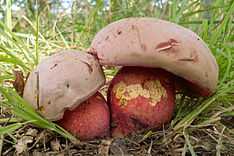Boletus legaliae
| Boletus legaliae | |
|---|---|
 | |
| Scientific classification | |
| Kingdom: | Fungi |
| Division: | Basidiomycota |
| Class: | Agaricomycetes |
| Order: | Boletales |
| Family: | Boletaceae |
| Genus: | Boletus |
| Species: | B. legaliae |
| Binomial name | |
| Boletus legaliae Pilát (1968) | |
| Synonyms | |
| |
| Boletus legaliae | |
|---|---|
|
| |
| pores on hymenium | |
| cap is convex | |
| hymenium is adnate | |
| stipe is bare | |
| spore print is olive-brown | |
| ecology is mycorrhizal | |
| edibility: poisonous | |
Boletus legaliae, previously known as B. splendidus or B. satanoides, is a basidiomycete fungus of the family Boletaceae. It is poisonous, with predominantly gastrointestinal symptoms, and is related to Boletus satanas.
Taxonomy
Boletus legaliae was described by Czech mycologist Albert Pilát in 1968. It is named after the French mycologist Marcelle Le Gal.[1] Boletus splendidus as described by Charles-Édouard Martín in 1894 is a synonym. The description of Boletus satanoides was too vague to be ascribed to any actual species.
Description
The cap is initially off-white, or coffee-coloured at the button stage. In mid life it often (but not always) turns a pale mouse grey. In old age the cap turns reddish, or what has been described as 'old rose'.[2] It may reach 14 cm (6 in) in diameter. The stipe is stocky, with a narrow red reticulation (net pattern) on an orange ground at the apex. This orange ground colour fades gradually towards the midsection, making the red reticulation more pronounced. At the base the reticulation is absent, and the stem turns dark vinaceous. Sometimes the stem detail can be faint, or even absent when covered with earth or leaf litter. The pores are initially red, but have an overall orange colour when mature, and they bruise blue. The flesh turns pale blue on cutting / dark vinaceous in the stem base. The flesh is said to smell of chicory.[3]
Similar species
Boletus satanas Lenz, which is found in broad-leaved woodland on calcareous soil, has a whiter cap, which turns brownish-ochre, lacking the overall reddish tones in maturity. It has a more nauseating smell, and it is poisonous, possibly deadly.[4]
Distribution and habitat
Uncommon in Southern England, and Europe. Grows with oak (Quercus) and beech (Fagus) often on neutral to acid soils.[2]
Toxicity
Very probably poisonous.
Group status
In Britain, all of the Boletes in the Satanas group are either very rare, endangered, or extinct. British Checklist
See also
References
- ↑ Bernard Crozes. "Les femmes mycologues" (in French). Mycological Society of Strasbourg. Retrieved 2008-07-04.
- ↑ 2.0 2.1 Régis Courtecuisse and Bernard Duhem ((British version) 1995). Mushrooms and Toadstools of Britain and Europe. Harper Collins. ISBN 0-00-220025-2. Check date values in:
|date=(help) - ↑ Marcel Bon (1987). The Mushrooms and Toadstools of Britain and North Western Europe. Hodder and Stoughton. ISBN 0-340-39935-X.
- ↑ Roger Phillips (2006). Mushrooms. Pan MacMillan. ISBN 0-330-44237-6.
External links
| Wikimedia Commons has media related to Boletus legaliae. |